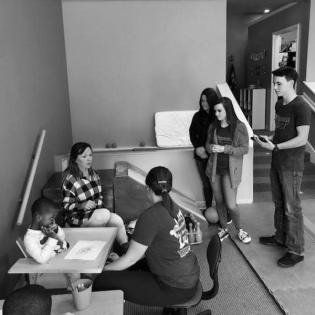Doors of Opportunity
In response to Martin Luther King, Jr.'s challenge, we explore what it means to be the best with the talents you have. The learners practice listening and responding with respect. Everyone has something to give, and this lesson helps us respect and celebrate the contributions we all can make to peaceful and inclusive communities. Students internalize "I matter in my communities."
The learner will be able to...
- analyze the text of a speech made by Dr. Martin Luther King, Jr.
- identify their potential talents and contributions to civil society.
- articulate why our differences make our communities strong.
- copies of the text from a speech Dr. King made to a Jr. High in 1967
- copies of the handout for analyzing the speech text.
- access to the Sustainable Development Goals of the U.N.
- chart paper for small groups and the instructions for Map Your Heartbreak.
- Some youth may investigate potential partners in the community for sharing talents and relationships, such as a preschool or retirement home.
- Arrange for the director of the partner organization to speak to the class about their population and their needs.
Tell your family about the Sustainable Development Goals and which one you are most interested in working toward. Tell others about why these goals belong to all of us, not just the U.N. or an unknown other.
How is a community better when people from different backgrounds meet and talk?
Map Your Heartbreak activity: https://www.learningtogive.org/resources/map-your-heartbreak-change-world
Instructions
Anticipatory Set:
Introduce the U.N. Sustainable Development Goals and challenge them to take action toward one of the goals. The goals are the focus of many nations and organizations and individuals around the world. Ask which goal they are most excited about learning more about.
In this lesson, we are focusing on #16, building peaceful and inclusive civil societies.
Reverend Martin Luther King, Jr. stands as an essential figure in American History. As a leader of the Civil Rights Movement during the 1950s and 1960s, Dr. King worked tirelessly to bring equality, inclusiveness, and dignity to all Americans. Many of his speeches are famous, but in this lesson, we analyze the language and impact of an address that is lesser known.
King spoke to a group of students at Barratt Junior High School in Philadelphia on October 26, 1967. Here, Dr. King not only spoke to this class, but to all youth in perpetuity about purpose and passion. Although he was assassinated on April 4, 1968, his message still resonates with us and infuses us all with an inspiration to continue on with his noble vision of what American could be.
Distribute copies of the speech and the handout for analyzing the text (below). Give them time to read and write about their text analysis.
Discuss what Dr. King challenged them to do and what steps they can personally take.
Put a chart paper on the table for each group of 3-5 learners to work together. Give them markers and instructions to complete the Map Your Heartbreak activity [https://www.learningtogive.org/resources/map-your-heartbreak-change-world]. This activity helps them identify their passions and what they can do to make a difference to make the world better.
Bring the whole group together and discuss what areas of needs came up in the different groups. Then ask what baby steps they can take toward problem-solving. What need can they address with their time, talent, and/or treasure?
Service Project: They form a community of people of different ages and different backgrounds.
In collaboration and over a few visits, they make art, stories, or share other talents with their new friends. If they can meet several times over the semester to build an ongoing relationship, the project will be stronger. Look for ways to contribute talents back and forth, including drawings, storytelling, and words of encouragement.
Philanthropy Framework
-
Strand PHIL.I Definitions of Philanthropy
-
Standard DP 01. Define Philanthropy
-
Benchmark MS.4 Give examples of how individuals have helped others.
-
-
Standard DP 02. Roles of Government, Business, and Philanthropy
-
Benchmark HS.1 Explain why needs are met in different ways by government, business, civil society and family.
-
-
-
Strand PHIL.II Philanthropy and Civil Society
-
Standard PCS 01. Self, citizenship, and society
-
Benchmark HS.3 Give examples of human interdependence and explain why group formation is one strategy for survival.
-
Benchmark MS.3 Give political and historic reasons why civil society groups have formed in the nation and world.
-
Benchmark HS.4 Describe and give examples of characteristics of someone who helps others.
-
Benchmark MS.4 Describe the characteristics of someone who helps others.
-
-
Standard PCS 02. Diverse Cultures
-
Benchmark MS.1 Examine several examples of philanthropic traditions practiced in diverse cultures.
-
Benchmark MS.3 Give an example of how philanthropy can transcend cultures.
-
-
Standard PCS 06. Philanthropy in History
-
Benchmark HS.2 Give an example of individual philanthropic action that influenced national or world history.
-
Benchmark MS.2 Give an example of individual philanthropic action that influenced the nation's history.
-
-
-
Strand PHIL.IV Volunteering and Service
-
Standard VS 02. Service and Learning
-
Benchmark MS.1 Select a service project based on interests, abilities and research.
-
Benchmark HS.1 Select a service project based on interests, abilities, and research.
-
-
